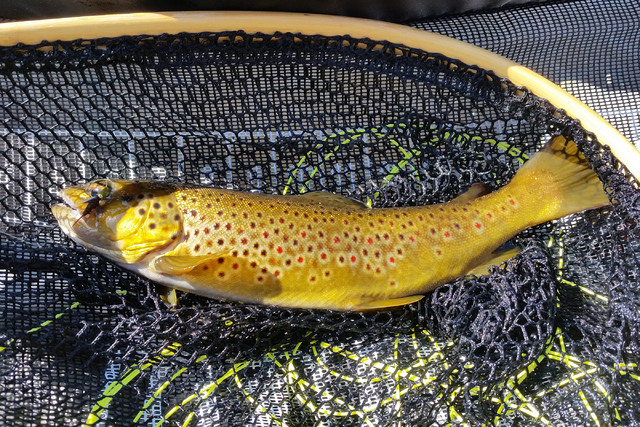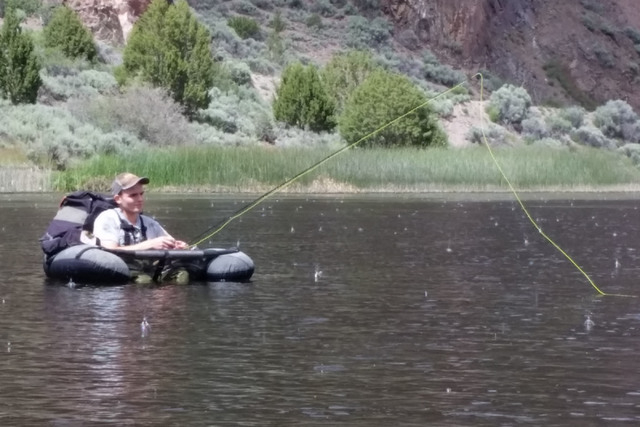Some spots just beg to be fished


Fish are where you find them. That’s just the way it is, but sometimes an angler comes across a place that just seems to shout, “Hey, throw your bait in here and you will catch a fish!”
Such was the case Saturday at Eagle Valley Reservoir in Lincoln County. There I found just such a place, where a tree reaches out over the water from near the bottom of a steep slope. Just west of the tree is a vertical rock face and beneath it is a small section of water, divided and protected from the main body of water by a thick stand of submerged vegetation.
I just had to fish that hole.
It took several minutes to work my way through the weeds, but I finally kicked my float tube into position for a cast. On the end of my sinking line was a bead head Prince Nymph that landed with a gentle plop at the near edge of a shaded spot of open water below the tree. I began stripping the line in — once, twice, three times. Just as I started that third strip, a fish hit my fly.
The take was anything but subtle. There was no mistaking it for a snag in the weeds. The fly had done its job, completely fooling a hungry fish. He smashed the fly with abandon, with only food in mind. Not unlike a teenager going after Dutch oven cobbler at summer camp.
When the fight was over, a plump brown trout lay in the bottom of my net. It measured only 12 inches, but that didn’t matter. It was a beautiful fish with golden brown coloring and black spots circled by a light, almost cream-colored ring. Among those were bright red spots. Those too were circled by a light-colored ring. This one called for a picture.
During our two-day fishing adventure in Lincoln County, my friends and I caught five species of fish, including rainbow and tiger trout, crappie and largemouth bass, but for me the highlight was the brown trout that came out of the hole below the tree.
Fish are simple creatures whose behavior is driven by just a handful of things. Among those are the need for food and cover. Insects account for much of a trout’s diet, though brown trout become meat eaters as they age. They will eat other fish and have been known to eat small terrestrial animals that fall into the water. Though I’ve never tried it, some anglers fish for large browns by throwing mice imitations at night.
Though fish are predators, they also are prey for other animals such as osprey, eagles and human beings. To survive, fish need a place to hide from predators looking to turn them into a meal.
The brown trout was in that hole beneath the tree not only because it provides a hiding spot, but also a source of food. Insects often fall from trees and other vegetation along the edge of waterways. Sometimes the odd mouse will fall from a tree limb as well. And the submerged aquatic vegetation is home to insects that live at least part of their life below the surface.
What more could a hungry fish want?
Another benefit from the tree is the shade it creates, helping to provide a cool spot in the water during the heat of the day. Water temperature is another factor that drives the behavior of fish. Trout, for instance, don’t fare well when water temperatures are too high. Bass aren’t as affected, and they do quite well in warm water. Thus, trout are considered cold-water species and bass are warm-water fish.
That said, both often will share the same water. Such is the case at Eagle Valley Reservoir.
Recognizing the basic needs of the species you are hoping to catch will help you recognize a fishing hole that just might hold the fish you’re seeking. This comes from experience and study. Having a friend or two to point the way doesn’t hurt, either.
While a fish’s needs vary by species or the type of water, others remain constant. Two of them are food and cover. Find those and you will stand a good chance of catching a fish or two.
Freelance writer Doug Nielsen is a conservation educator for the Nevada Department of Wildlife. His “In the Outdoors” column, published Thursday in the Las Vegas Review-Journal, is not affiliated with or endorsed by the NDOW. Any opinions he states in his column are his own. He can be reached at intheoutdoorslv@gmail.com.












